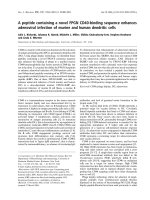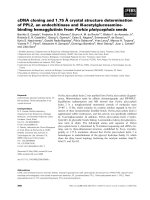Crystal structure determination of HEX1 and human GEMININ 70 152
Bạn đang xem bản rút gọn của tài liệu. Xem và tải ngay bản đầy đủ của tài liệu tại đây (3.36 MB, 161 trang )
CRYSTAL STRUCTURE DETERMINATION OF
HEX1 AND HUMAN GEMININ70-152
YUAN PING
NATIONAL UNIVERSITY OF SINGAPORE
2004
Founded 1905
CRYSTAL STRUCTURE DETERMINATION OF
HEX1 AND HUMAN GEMININ70-152
YUAN PING
(B.S., M.Sc.)
A THESIS SUBMITTED
FOR THE DEGREE OF DOCTOR OF PHILOSOPHY
INSTITUTE OF MOLECULAR AND CELL BIOLOGY
NATIONAL UNIVERSITY OF SINGAPORE
2004
Acknowledgements
I
ACKNOWLEDGEMENTS
I want to express my sincere and deep gratitude to my supervisor Dr.
Kunchithapadam Swaminathan for his expert guidance, encouragement and support to
undertake and finish my Ph.D. study successfully.
Next, I wish to express my special thanks to Prof. Anindya Dutta (Byrd
Professor of Biochemistry & Molecular Genetics, Professor of Pathology, University
of Virginia Health Sciences Center) for initiating the project of structure determination
of Geminin and generously allowing me to include the functional data in my thesis to
get the story complete. Besides, he also supported me to work for half a year in his
previous lab at Brigham and Women’s Hospital, Harvard Medical School. There I
started to learn DNA replication and exposed myself to a world of first class research
that greatly enlarged my vision. I also wish to thank Drs. James Wohlschlegel,
Zophonias O. Jonsson, Yuichi Machida, Suman Kumar Dhar, Sandeep Saxena, and
other members in his lab for their kind assistance and valuable training in molecular
biology.
I owe my sincere thanks to our collaborators Prof. Nam-Hai Chua and Dr.
Gregory Jedd (Laboratory of Plant Molecular Biology, The Rockefeller University) for
initiating the project of crystal structure determination of Hex1 and exchanging data
during the collaboration.
I wish to express my sincere gratitude to Prof. Subramanyam Swaminathan,
Drs. Desigan Kumaran, and Howard Robison (Department of Biology, Brookhaven
Acknowledgements
II
National Laboratory) for their great help in data collection and valuable suggestions in
structure determination.
I am very glad to express my sentiments to my colleagues of the structure lab,
especially Ms. Nan Li, Sifang Wang, and Sheemei Lok, who created a friendly
atmosphere.
Here I also want to express my deep thanks to my parents who raised me up
and encouraged me to pursue the doctoral degree.
Finally, I want to express my greatest love and regards to my husband Mr.
Yifeng Sun for his full support and encouragement. Without his help, I will not be able
to finish my Ph.D. and have such a happy life. Here, I dedicate this thesis to the crystal
of our love - our son, Ruiqian Sun.
Table of contents
III
TABLE OF CONTENTS
ACKNOWLEDGEMENTS I
TABLE OF CONTENTS III
NOMENCLATURE X
LIST OF FIGURES XI
LIST OF TABLES XIII
SUMMARY XIV
CHAPTER 1 INTRODUCTION ON CRYSTAL STRUCTURE
DETERMINATION 1
1.1 THE HISTORY OF X-RAY CRYSTALLOGRAPHY ···········································1
1.1.1 Discovery of X-rays···············································································1
1.1.2 Application of X-rays to molecular structure determination ··················1
1.2 X-
RAY SOURCES AND DIFFRACTION INSTRUMENTS
···································2
1.2.1 X-ray sources ·························································································2
1.2.2 Diffraction instruments ··········································································4
1.2.3 Data reduction························································································6
1.3 B
ASIC CONCEPTS OF
X-
RAY CRYSTALLOGRAPHY
·····································7
1.3.1 Unit-cell·································································································7
1.3.2 Lattice, point group and space group ·····················································7
Table of contents
IV
1.3.3 hkl plane ································································································9
1.4 THE DIFFRACTION OF X-RAYS BY CRYSTALS ············································9
1.4.1 Scattering by atoms in a crystal······························································9
1.4.2 Waves and addition··············································································10
1.5 B
RAGG
'
S LAW
·························································································11
1.5.1 Bragg's law···························································································11
1.5.2 Reciprocal lattice ·················································································12
1.5.3 Bragg's law in reciprocal lattice ···························································13
1.6 FOURIER TRANSFORM ·············································································15
1.6.1 Fourier series························································································15
1.6.2 The Fourier transform: general features ···············································16
1.6.3 Electron density as a Fourier series······················································17
1.6.4 Structure factor as a Fourier series·······················································18
1.7 P
HASE PROBLEM
·····················································································20
1.8
M
ETHODS TO SOLVE THE PHASE PROBLEM
··············································20
1.8.1 The heavy-atom method (isomorphous replacement)···························20
1.8.1.1 The Patterson function ··································································20
1.8.1.2 Patterson symmetry·······································································21
1.8.1.3 Heavy-atom derivative preparation ···············································22
1.8.1.4 Heavy-atom determination····························································23
1.8.1.5 Protein phase determination ··························································24
1.8.2 The MAD method················································································26
Table of contents
V
1.8.2.1 Anomalous scattering····································································26
1.8.2.2 Extracting phase from anomalous scattering·································27
1.8.3 Direct methods·····················································································30
1.8.4 Molecular replacement: related proteins as phasing models·················32
1.8.4.1 Isomorphous phasing models························································32
1.8.4.2 Non-isomorphous phasing models ················································33
1.9 IMPROVEMENT OF ELECTRON DENSITY MAP AND MODEL BUILDING ·······34
1.9.1 Weighting factor ··················································································34
1.9.2 Improving the map···············································································35
1.9.2.1 Solvent flattening ··········································································35
1.9.2.2 Phase extension·············································································35
1.9.2.3 Non-crystallographic symmetry averaging····································36
1.9.3 Model building·····················································································36
1.9.4 Refinement···························································································37
1.9.4.1 Least-squares methods ··································································37
1.9.4.2 Crystallographic refinement··························································38
1.9.4.3 Molecular dynamics refinement····················································38
1.9.4.4 Additional parameters for refinement············································39
1.10
F
INAL STRUCTURE
··················································································40
CHAPTER 2 HEX1 CRYSTAL LATTICE IS REQUIRED FOR
WORONIN BODY FUNCTION IN
NEUROSPORA CRASSA
42
2.1 INTRODUCTION ·······················································································42
Table of contents
VI
2.1.1 Discovery of Woronin body and its function ·······································42
2.1.2 The category of Woronin body ····························································44
2.1.3 Hex1 is responsible for the function of Woronin body·························44
2.1.4 Woronin body is a new type of peroxisome ·········································45
2.1.5 Hex1 has the characteristics of self-assembly ······································47
2.2 H
EX
1
STRUCTURE DETERMINATION
························································47
2.2.1 Purpose of Hex1 structure determination ·············································47
2.2.2 Experimental methods··········································································48
2.2.2.1 Expression and purification of native Hex1 ··································48
2.2.2.2 Selenomethionine Hex1 expression and purification·····················49
2.2.3 Hex1 crystallization ·············································································51
2.2.3.1 Native crystal ················································································51
2.2.3.2 Selenomethionine crystal ······························································52
2.2.4 Hex1 data collection·············································································53
2.2.5 Selenium position determination··························································54
2.2.6 Electron density map············································································56
2.2.7 Model building and refinement····························································57
2.3 H
EX
1
CRYSTAL LATTICE IS REQUIRED FOR WORONIN BODY ASSEMBLY
··60
2.3.1 Overall structure of Hex1·····································································60
2.3.2 Three groups of intermolecular interaction ··········································61
2.3.3 Interface of three groups of interaction ················································64
2.3.4 The packing of Hex1············································································66
Table of contents
VII
2.3.5 Point mutations in Hex1 abort in vitro crystallization ··························68
2.3.6 Point mutations in Hex1 abort Woronin body formation ·····················71
2.4 E
VOLUTIONARY ORIGIN OF
H
EX
1 ···························································74
2.4.1 Hex1 structure homologs ·····································································74
2.4.2 eIF-5A··································································································77
2.4.3 Difference between Hex1 and EIF-5A ·················································78
2.4.4 Selected Hex1 residues are highly conserved in eIF-5A ······················79
2.4.5 Evolutionary relationship between Hex1 and eIF-5A···························81
2.5 D
ISCUSSION
····························································································81
CHAPTER 3 DIMERIZATION OF GEMININ COILED COIL
REGION IS NEEDED FOR ITS FUNCTION IN CELL CYCLE 84
3.1 I
NTRODUCTION
·······················································································84
3.1.1 Discovery of Geminin··········································································84
3.1.2 Role of Geminin in DNA replication ···················································84
3.1.3 Role of Geminin in Neuron Differentiation··········································88
3.1.4 Role of Geminin in apoptosis·······························································89
3.1.5 Geminin depletion cause G2 phase arrest in Xenopus development·····89
3.1.6 Behaviour of endogenous Geminin······················································90
3.1.7 Domain organization of Geminin·························································91
3.2
CRYSTAL STRUCTURE DETERMINATION OF
G
EMININ
······························92
3.2.1 Full length Geminin purification and Crystallization ···························92
3.2.2 Identification of Cdt1 binding domain of Geminin ······························94
Table of contents
VIII
3.2.2.1 Past work on the domain study······················································94
3.2.2.2 Cdt1 binding study········································································95
3.2.2.3 Function test of Geminin70-152····················································97
3.2.3 Expression and purification of Geminin70-152····································99
3.2.3.1 Expression and purification of Geminin70-152·····························99
3.2.3.2 Expression and purification of Geminin70-152 containing selenium
····································································································101
3.2.4 Crystallization of native and selenomethionine Geminin70-152········102
3.2.5 Crystal data collection and processing ···············································103
3.2.6 Model building and refinement··························································105
3.3 S
TRUCTURE OF
G
EMININ COILED COIL DOMAIN
····································108
3.3.1 The overall structure of Geminin coiled coil domain ·························108
3.3.2 Inter-subunit interactions of the Geminin coiled coil domain·············110
3.3.3 Surface of Geminin coiled coil···························································114
3.4 DIMERIZATION OF GEMININ THROUGH ITS COILED COIL DOMAIN IS
NECESSARY FOR ITS FUNCTION
········································································116
3.4.1 Dimerization of Geminin through coiled coil region is necessary for its
interaction with Cdt1 in vitro and in vivo·······················································116
3.4.2 Mutant Geminin LZ can not inhibit DNA replication in Xenopus egg
extracts···········································································································119
3.4.3 Geminin LZ can not inhibit replication of EBV plasmid····················122
3.4.4 Geminin LZ fails to block the cell cycle ············································124
3.5 DISCUSSION ······················································································127
PUBLICATIONS RELATED TO THIS THESIS 129
Table of contents
IX
APPENDIX A Medium and Solution 130
REFERENCES 133
Nomenclature
X
NOMENCLATURE
X-ray crystallography, unit-cell, lattice, point group, space group, hkl plane, reciprocal
lattice, electron density map, Fourier series, Fourier transformation, data reduction,
anomalous scattering, MIR, MAD, MR, direct method, refinement
Hex1, Woronin body, eIF-5A
DNA replication, pre-replication complex, neuralization, apoptosis, leucine zipper,
coiled coil
List of figures
XI
LIST OF FIGURES
Figure 1-1····················································································································· 11
Figure 1-2····················································································································· 13
Figure 1-3····················································································································· 14
Figure 1-4····················································································································· 18
Figure 1-5····················································································································· 26
Figure 1-6····················································································································· 30
Figure 2-1····················································································································· 43
Figure 2-2····················································································································· 49
Figure 2-3····················································································································· 51
Figure 2-4····················································································································· 52
Figure 2-5····················································································································· 53
Figure 2-6····················································································································· 60
Figure 2-7····················································································································· 64
Figure 2-8····················································································································· 65
Figure 2-9····················································································································· 68
Figure 2-10··················································································································· 70
Figure 2-11··················································································································· 73
Figure 2-12··················································································································· 75
Figure 2-13··················································································································· 76
Figure 2-14··················································································································· 80
Figure 3-1····················································································································· 88
Figure 3-2····················································································································· 91
List of figures
XII
Figure 3-3····················································································································· 94
Figure 3-4····················································································································· 95
Figure 3-5····················································································································· 96
Figure 3-6····················································································································· 97
Figure 3-7····················································································································· 98
Figure 3-8··················································································································· 100
Figure 3-9··················································································································· 102
Figure 3-10················································································································· 103
Figure 3-11················································································································· 109
Figure 3-12················································································································· 114
Figure 3-13················································································································· 115
Figure 3-14················································································································· 117
Figure 3-15················································································································· 120
Figure 3-16················································································································· 123
Figure 3-17················································································································· 125
List of tables
XIII
LIST OF TABLES
Table 2-1 ······················································································································ 54
Table 2-2 ······················································································································ 56
Table 2-3 ······················································································································ 59
Table 2-4 ······················································································································ 69
Table 3-1 ···················································································································· 104
Table 3-2 ···················································································································· 106
Summary
XIV
SUMMARY
X-ray crystal structure determination is one of the most powerful methods to
determine the macromolecular structure and study the relationship between structure
and function of macromolecules.
With this method, I have solved the crystal structure of Hex1, the component of
Woronin body in Neurospora crassa, at 1.8 Å by the MAD method. The Woronin
body is a dense-core vesicle specific to filamentous ascomycetes where it functions to
seal the septal pore in response to cellular damage. Previous work showed that the
Hex1 protein self-assembles to form the solid core of the Woronin body. The structure
of Hex1 reveals the existence of three intermolecular interfaces that promote the
formation of a three-dimensional protein lattice. Point mutation of the intermolecular
contact residues and expression of an assembly-defective Hex1 mutant result in the
production of aberrant Woronin bodies, which possess a soluble non-crystalline core.
This mutant also fails to complement Hex1 deletion in Neurospora crassa,
demonstrating that the Hex1 protein lattice is required for Woronin body function. In
addition to sharing sequence similarity, the tertiary structure of Hex1 is remarkably
similar to that of eukaryotic initiation factor 5A (eIF-5A). Thus it suggests that a new
function of Hex1 has evolved following the duplication of an ancestral eIF-5A gene,
which may define an important step of fungal evolution.
With the X-ray crystallography method, I have also solved the crystal structure
of the Cdt1 binding domain of Geminin at 2.0 Å. For a cell to survive, the
chromosome of the cell should be accurately replicated only once and then equally
Summary
XV
divided to two daughter cells. Very subtle biological switches control these two steps.
Geminin plays an essential role in controlling the chromosome to replicate only once.
Before DNA replication, a pre-replication complex (pre-RC) should be formed in a
stepwise manner. Origin recognition complex (Orc) is always associated with the
chromatin DNA origin. When cells exit mitosis and enter G1, Cdc6 and Cdt1 will load
on Orc. Then microchromosome maintenance (MCM) complex will join in to form
pre-RC and it is the mark of the beginning of S phase. Only the DNA that has been
loaded with pre-RC, called “licensed”, can be replicated. To achieve the target that
DNA replicates only once during S phase, Geminin will function to ensure that no new
pre-RC is formed on an already fired origin. By interacting with Cdt1, Geminin targets
Cdt1 for degradation. Without Cdt1, MCM will not be able to load to chromatin. Thus
no PreRC will be formed and a fired origin will not be fired again. Residues 70-152 is
the functional domain of Geminin that can interact with Cdt1 and also inhibit EBV
oriP based transient plasmid replication. The crystal structure of Geminin70-152
clearly reveals amino acids 92 to 152. Amino acids from 70 to 91 are missing in the
electron density map, which suggests the region may be highly flexible. The fragment
from amino acid 94 to 150 forms dimerized parallel coiled coil structure. This
indicates that full length Geminin also forms a dimer. Point mutations of leucine and
isoleucine residues in the coiled coil domain disrupt dimerized Geminin and also
abolish its interaction with Cdt1 in vitro and in vivo. This mutant also loses its ability
to inhibit EBV plasmid replication as well as DNA replication in Xenopus egg extract.
These data show the coiled coil structure of Geminin is critical for its interaction with
Cdt1 and inhibits DNA replication. Further experimental data reveal that Geminin 93-
152 is sufficient for Cdt1 interaction, but not sufficient for inhibiting Cdt1’s function.
Residues 70 to 92 appear to be necessary to inhibit DNA replication. The physical
Summary
XVI
contiguity of residues 70 to 93 with the coiled coil domain might indicate that the
critical function of this accessory domain may either stabilize the interaction of Cdt1
with Geminin or make additional contacts with Cdt1 that interfere with whatever
function is necessary for co-operating with Cdc6 to load the Mcm2-7 helicases.
Alternatively, this domain of Geminin might have a novel interaction partner. Further
work on the structure of the Geminin-Cdt1 complex may give us more hints of the
mechanism.
Chapter 1 introduction on Crystal structure Determination
1
CHAPTER 1 INTRODUCTION ON CRYSTAL STRUCTURE
DETERMINATION
1.1 T
HE HISTORY OF
X-
RAY CRYSTALLOGRAPHY
1.1.1 Discovery of X-rays
Discovered by German physicist Wilhelm Conrad Roentgen in 1895, X-rays lie
in the electromagnetic spectrum between ultraviolet and gamma radiation and have
wavelengths of 0.1-100 Å. They are usually produced by rapidly decelerating fast
moving electrons and converting their energy of motion into quanta of radiation (Stout,
1989). When high energy electrons collide with and displace an electron from a low
lying orbital in a target metal atom, an electron from a higher orbital drops into the
resulting vacancy, emitting its excess energy as an X-ray photon (Rhodes, 2000). The
wavelengths (
λ
) of emission lines are longer for elements of lower atomic number Z.
For instance, electrons dropping from the L shell of copper (Z = 29) to replace the
displaced K electrons (L to K or K
α
transition) emit X-rays of λ = 1.54 Å. The M→K
transition produces a nearby emission band (K
β
) at 1.39 Å. For molybdenum (Z = 42),
λ (K
α
) = 0.71 Å and λ (K
β
) = 0.63 Å.
1.1.2 Application of X-rays to molecular structure determination
In 1912, Von Laue’s group discovered X-ray diffraction and this discovery
Chapter 1 introduction on Crystal structure Determination
2
gave rise to the development of a very rich scientific period and created a new
academic branch – crystal structure determination. One year later, W. L. Bragg
determined the first structure. From then on, crystal structure determination is broadly
undertaken on inorganic and organic molecules (Buerger, 1990). Currently, there are
about 17,000 unique structures of protein, peptide, virus, protein/nucleic acid complex,
nucleic acid and carbohydrate molecules, all determined by X-ray crystallography, and
deposited in the Protein Data Bank. This number is increasing day by day. Crystal
structure determination is definitely the most popular and powerful method to solve a
macromolecular structure.
1.2 X-RAY SOURCES AND DIFFRACTION INSTRUMENTS
1.2.1 X-ray sources
The most commonly used X-rays are produced by bombarding metals (copper
or molybdenum) with electrons produced by a heated filament and accelerated by an
electric field.
A monochromatic (single wavelength) source of X-rays is desirable for
crystallography. Mostly, copper and molybdenum are used as the anode material and
they generate suitable X-rays. Generally, the weaker K
β
radiation is removed. Copper
radiation is widely used for detection by film, which is more sensitive to Cu K
α
than to
that of molybdenum. Molybdenum, which gives short wavelength X-rays, and hence
better resolution, are more commonly used when X-rays are detected by scintillation
counters, as in diffractometers.
Chapter 1 introduction on Crystal structure Determination
3
There are three common X-ray sources: X-ray tube, rotating anode tube, and
the particle accelerator that produces synchrotron radiation in the X-ray region. In the
X-ray tube, electrons from a hot filament (near the cathode) are accelerated by an
electrical field and collide with a water cooled anode, which is made of the target
metal. Output from the X-ray tube is limited by the amount of heat, which can be
dissipated from the anode by circulating water. Rotating anode tubes will generate
high X-ray output, in which the target is a rapidly rotating metal block. This
arrangement improves heat dissipation by spreading the electron bombardment over a
much larger area of metal.
Particle accelerators, which are used by physicists to study subatomic particles,
are the most powerful X-ray sources. In these giant rings, electrons or positrons
circulate at velocities near the speed of light, driven by energy from radio frequency
transmitters, and maintained in circular motion by powerful magnets. A charged body
like an electron emits energy (synchrotron radiation) when forced into circular motion,
and in accelerators, the energy is emitted as X-rays. Accessory devices called
“wigglers” cause additional bending of the beam, thus increasing the intensity of
radiation. Systems of focusing mirrors and monochromators that are tangential to the
storage ring provide powerful monochromatic X-rays at selectable wavelengths. With
this principle, the X-ray data that require several hours of exposure using a rotating
anode source can often be obtained in a few seconds or minutes at the synchrotron
source. Another advantage is that the wavelength of synchrotron X-rays can be
selected as needed, which can help to solve the phase problem.
Chapter 1 introduction on Crystal structure Determination
4
1.2.2 Diffraction instruments
Any X-ray diffraction instrument consists of two main parts: a mechanical part
for rotating the crystal and a detecting device to measure the position and intensity of
diffracted beams.
Formerly, Buerger’s precession camera and Weissenberg’s rotation camera
were used for collecting data. In both types of camera, X-ray film was used as the
detector. The precession camera has the advantage of giving an undistorted image of
the reciprocal lattice. Unit-cell dimensions and symmetry in the crystal can be easily
derived from the undistorted image. However, the precession camera is not suitable for
three-dimensional X-ray data collection, because it only records one reciprocal layer
per exposure. The rotation camera registers data more efficiently, but recognition of
diffraction spots is more complicated. Data are collected in a contiguous oscillation
range. Some spots appear partly on one and partly on the next or previous exposures.
Two “partials” are treated as individual reflections and their intensities are added at a
later stage. Nevertheless, accuracy in the intensity of reflections is sometimes lower
than that of fully recorded reflections and for this reason they are completely neglected.
Superior resolution can be obtained from the fine grain of the photographic film, but
because processing the film is somewhat cumbersome and time consuming, it is not
very much used in crystallography nowadays.
The third class of instrument is a computer controlled diffractometer, which has
a single counter, normally a scintillation counter. Although the scintillation counter is
no longer widely used for macromolecular data collection today, the goniostat
construct is standard in X-ray crystallography. The classical Eulerian geometry
goniostat has four circles. The X-ray beam, the counter and the crystal lie in a
Chapter 1 introduction on Crystal structure Determination
5
horizontal plane. The crystal is located at the intersection of the circles. To measure the
intensity of a diffracted beam, the crystal must be oriented such that the diffracted
beam will also be in the horizontal plane. This orientation is achieved by the rotation
of the crystal around three axes:
φ
(phi),
ω
(omega), and
χ
(chi). The counter can be
rotated in the horizonal plane around the 2
θ
-axis, which is coincident with, but
independent of the
ω
-axis. Data collection is done either with the
ω
and 2
θ
axes
coupled or with the 2
θ
axis fixed and the crystal scanned by rotation around the
ω
axis.
In a kappa geometry goniostat, the equivalent rotation of the crystal is achieved by the
three axes φ, ω and κ (kappa).
Lately, the classical photographic film has been replaced completely by the
introduction of much faster electronic area detectors and image plates. The basic
difference between the area detector and photographic film is that area detectors scan
through a diffraction spot in small intervals (e.g., 0.1°), giving a three-dimensional
profile of the spot. Area detectors are currently based on either a gas filled ionization
chamber or an image intensifier, coupled to a video system. The gas filled chambers
are essentially single photon counting X-ray detectors. In the video based area
detectors, the diffraction pattern is collected on a fluorescent screen. In another kind of
area detector the video tube is replaced by a charge coupled device (CCD). They have
a high dynamic range, combined with excellent spatial resolution, low noise and a high
count rate. The image plate is used in the same manner as the X-ray film but it has
several advantages. The image plate is made by depositing a thin layer of inorganic
storage phosphor on a flat base. Image plates are more sensitive than the X-ray film
and their dynamic range is much wider (1: 10
4
– 10
5
). The plate can be erased by
exposure to intense white light and used repeatedly. It is also highly sensitive to the
Chapter 1 introduction on Crystal structure Determination
6
synchrotron radiation at shorter wavelengths (around 0.65 Å; an advantage of short
wavelengths is that the absorption of the X-ray beam in a protein crystal becomes
negligible and no absorption correction is required). The disadvantage of the image
plate is, like the photographic film, it requires a multistep process: exposure as the first
step and reading as the second step (Drenth, 1994).
1.2.3 Data reduction
The goal of data collection is to collect a set of consistently measured and
indexed intensities for as many reflections as possible. The preliminary manipulation
of these intensities is to convert them to a corrected and more generally usable form.
This process is named as data reduction. The most important quality derived from the
intensities is structure factor (structure amplitude |F
hkl
|), with the relationship |F|
∝
I
1/2
.
Because of viability in the diffracting power of crystals, intensity of the X-ray
beam, slow deterioration of the crystal during data collection, and also data maybe
obtained from more than one crystal, it can not be assumed that absolute intensities are
consistent from one block of data to the next. An obvious way to obtain this
consistency is to compare reflections of the same index that were measured from more
than one crystal and scale the intensities of the two blocks of data so that identical
reflection are given identical intensities. This process is called scaling. Scaling will
help generate a list of internally consistent intensities for most of the available
reflections (Rhodes, 2000; Stout, 1989).
Chapter 1 introduction on Crystal structure Determination
7
1.3 BASIC CONCEPTS OF X-RAY CRYSTALLOGRAPHY
1.3.1 Unit-cell
When molecular substances enter the crystalline state from solution, individual
molecule adopts one or only a few orientations. Although imaginary, the smallest box
of definite volume and actual shape can be assumed to pack the molecule or all
specifically orientated molecules. The crystal is an orderly three-dimensional repetition
of this box. In crystallography, this identical box is defined as unit-cell (Buerger, 1966).
The dimensions of a unit-cell are designated by six parameters, three lengths of
the edges a, b and c, and three unique interaxial angles
α
,
β
and
γ
. A cell in which a
≠
b
≠
c and
α
≠
β
≠
γ
is known as triclinic while a = b = c,
α
=
β
=
γ
= 90
°
is cubic.
Other unit-cells, monoclinic, orthorhombic, tetragonal, rhombohedral and hexagonal,
will have a varying degree of arrangements for these parameters. The arrangement of
symmetry elements (a crystal system) demands a particular unit-cell. If the unit-cell of
one crystal system has dimensions that mimic a different system, it is purely accidental.
1.3.2 Lattice, point group and space group
For many geometrical purposes, it is convenient to ignore the specific nature of
the motif and concentrate attention on the geometry of repetition. In these cases it is
sufficient to consider using a point at the corners or vertices of the unit-cell to
represent the whole unit-cell. The array of these points is called lattice. There are 14
basic unit-cells in three dimensions, called Bravais lattices. The Bravais lattices are the
distinct lattice types which, when repeated can fill the whole space. They can be
classified as primitive (simple unit-cell), face centered (point at the center of each face),









